
-
While nearly one quarter of Americans currently see a therapist, almost half (48%) plan to start within the next year—led by Millennials (70%) and Gen Z (57%).
-
Personal finances are a major source of anxiety, with more than half of respondents (54%) identifying it a source of stress. Family and relationship dynamics follow closely behind, affecting 42% of respondents.
-
94% of Americans are willing to confide in their personal support network, but 66% feel more comfortable sharing certain information with a therapist rather than with family or friends.
-
A strong majority (87%) of people report life improvements from therapy, including boosted confidence, happiness, and self-esteem. And 93% believe mental and physical health are connected, highlighting the importance of a holistic approach to healthcare.
A recent Thriveworks survey explored Americans’ perspectives on therapy and mental health, revealing key insights into the factors that influence their decisions.
The survey highlights the main reasons why Americans do or don’t go to therapy, the leading causes of anxiety today, and which generation is most inclined to seek mental health support, among other things. These findings offer valuable information that can help shape a better understanding of mental health trends and preferences in the United States.
Who Is in Therapy?
Nearly one quarter (23%) of respondents reported that they currently see a therapist, whether regularly or occasionally. More than one-third (38%) shared that they had consulted a therapist in the past, though not within the last two years. Similarly, 38% indicated they had never sought therapy at any point.
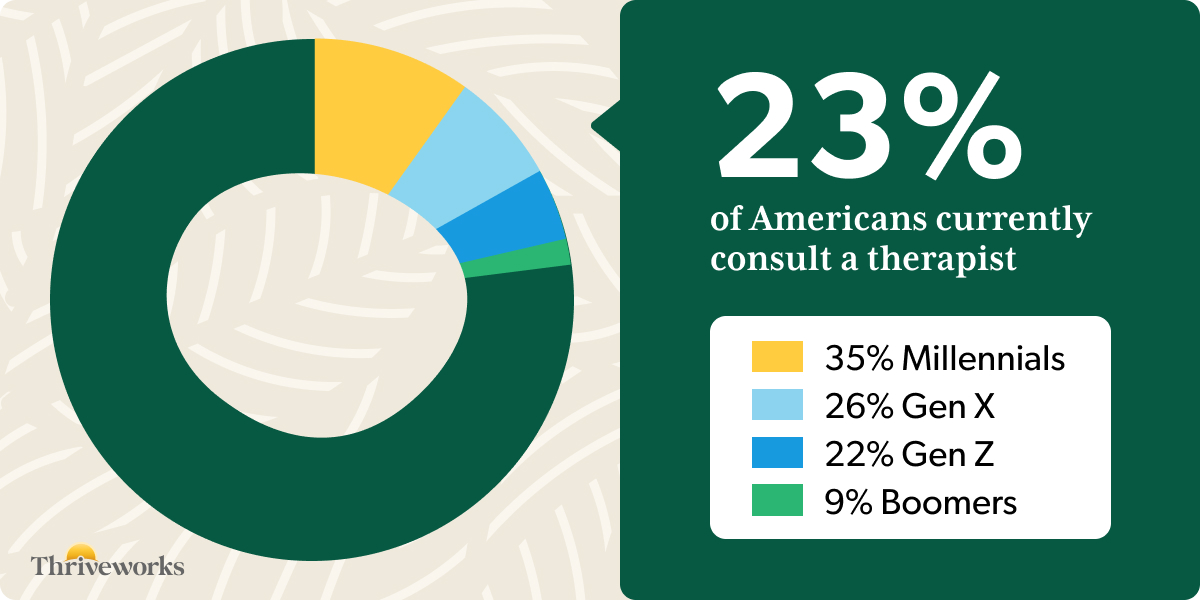
Who Plans to Start Therapy?
Nearly half of Americans (48%) expressed plans to seek therapy within the next year—a 5% increase from last year. However, a significant portion (52%) reported having no intention of starting therapy anytime soon.
When broken down by demographics, some surprising generational differences emerge. While a slight majority of overall respondents stated it was unlikely they would start therapy, generational trends tell a different story.
- Millennials are the most likely to seek therapy, with 70% planning to attend sessions within the next 12 months and only 30% saying they would not.
- Gen Z and Gen X showed narrower margins but still leaned toward seeking therapy, with 57% and 52%, respectively, reporting plans to find a therapist.
- Baby Boomers, however, were overwhelmingly unlikely to start therapy—80% stated they would not seek mental health services, making them the least likely generation to pursue therapy.
These findings highlight how attitudes toward therapy vary significantly across generations and provide insight into shifting mental health trends in the U.S.
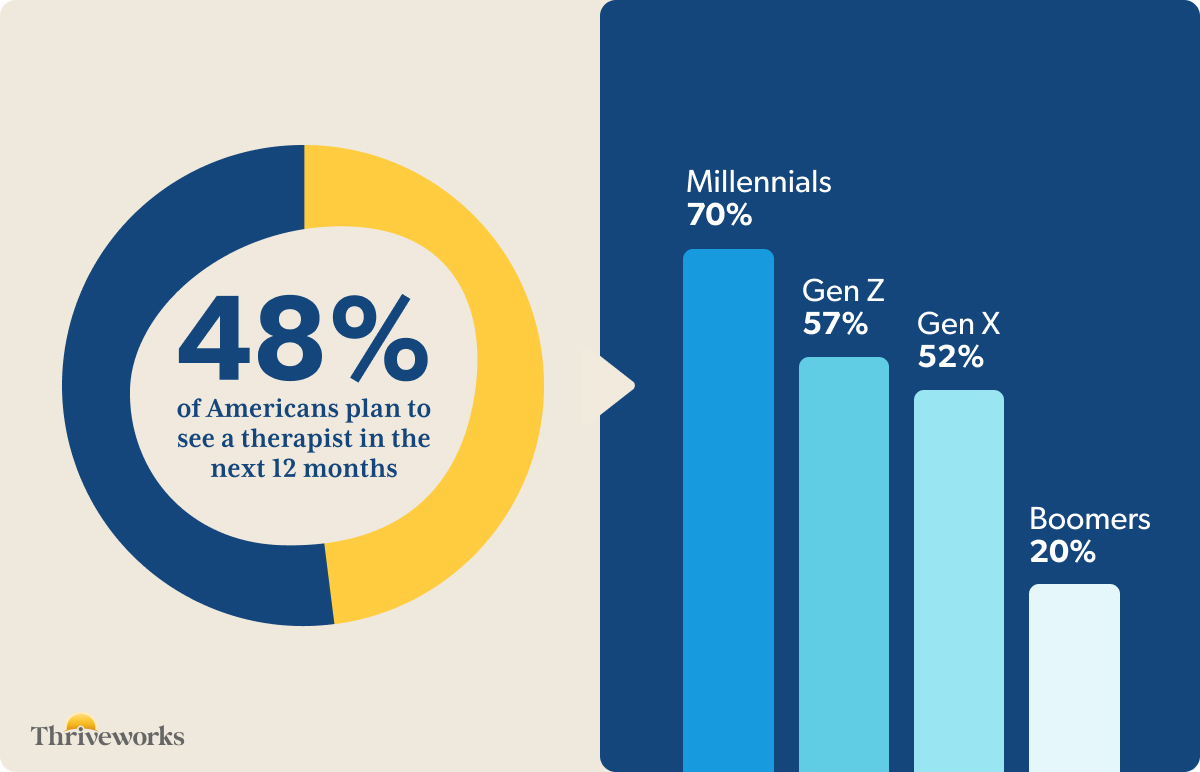
What Are the Reasons Americans Don’t Go to Therapy?
To better understand barriers to therapy, Thriveworks asked respondents who have not sought mental health services why they don’t plan to attend. The most commonly cited reason was that they didn’t feel therapy was necessary (55%), followed by concerns about expense (27%).
Other reasons included:
- No time (15%)
- Therapy isn’t covered by their insurance (14%)
- Difficulty finding a therapist they liked in their area (12%)
- A bad experience with a therapist in the past (7%)
- Difficulty getting an appointment when they needed it (6%)
- Doubts about therapy’s effectiveness (4%)
- Embarrassment over seeking therapy (4%)
From a generational perspective, necessity was the top reason cited by Millennials, Gen X, and Baby Boomers for avoiding therapy, with expense coming in second. Baby Boomers showed the strongest consensus, with 75% agreeing they didn’t feel therapy was necessary.
Millennials and Gen X displayed closer margins between necessity and expense. Among Millennials, 42% reported they didn’t feel therapy was necessary, while Gen X respondents showed slightly higher agreement at 49%.
Gen Z stood out as the only generation where cost was the leading barrier to therapy (43%), followed by necessity at 37%. These findings underscore how generational attitudes and financial concerns shape decisions about seeking mental health care.

Most Americans Don’t Keep Therapy a Secret
Our survey revealed that the majority of Americans (90%) are open to sharing their therapy status with at least one person in their life. Over half of respondents said they would feel comfortable informing their family (61%) or their spouse/partner (54%), while 45% indicated they would likely share this information with close friends.
Smaller percentages reported being willing to disclose their therapy status to social media friends (12%), coworkers (9%), or bosses (8%). However, 10% of respondents stated they wouldn’t feel comfortable sharing that they’re in therapy with anyone.
Who Do Americans Confide in, if Not a Therapist?
While not everyone feels the need to see a therapist, most Americans are willing to confide in others about their mental health. An overwhelming majority (94%) said they would turn to someone in their personal network for support.
Unsurprisingly, people are most likely to confide in those closest to them:
- Family members (57%)
- Close friends (54%)
- Spouses or partners (48%)
Other responses included:
- A medical professional other than a therapist, such as a primary care doctor (18%)
- Religious leaders (16%)
- Coworkers (9%)
- Wouldn’t confide in anyone (8%)
- Online communities, such as Reddit or Facebook groups (7%)
- AI tools like ChatGPT (3%)
- Bartenders (3%)
- Uber or taxi drivers (2%)
- Manicurist (2%)
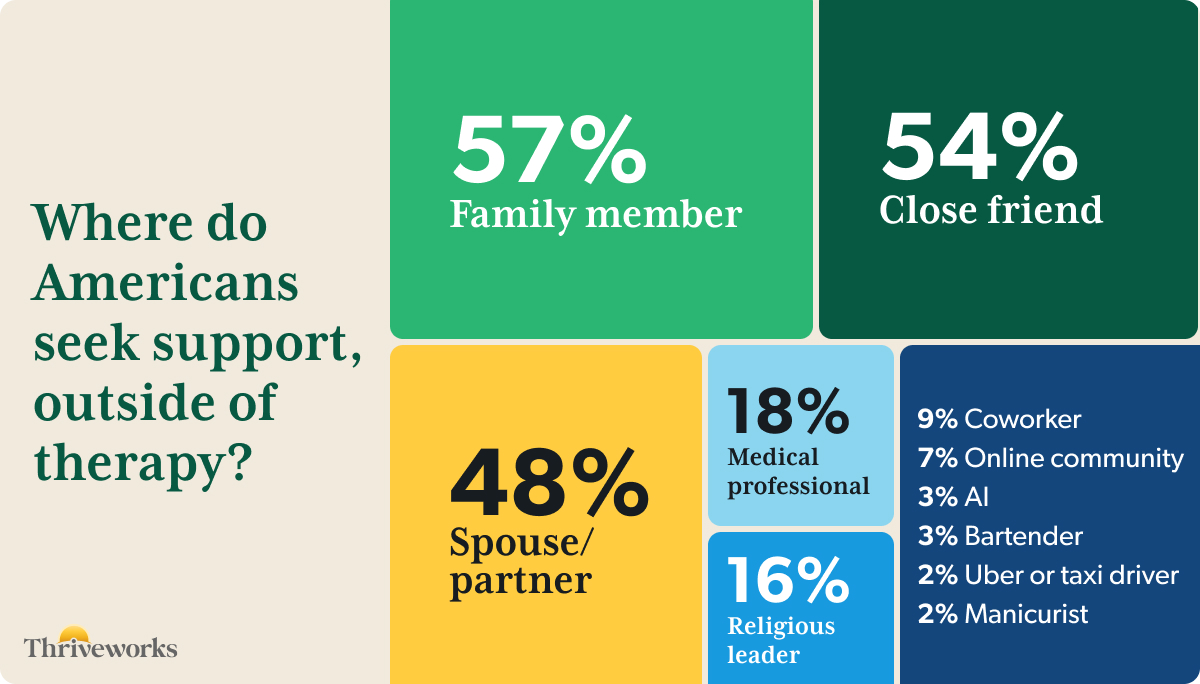
Gender Differences in Confiding Behavior
The data also revealed slight gender disparities. Female respondents were more likely to confide in family members (59%) or close friends (57%) compared to male respondents (55% and 52%, respectively). Conversely, men were more inclined to talk to their spouse or partner (51%), compared to women (44%).
These findings highlight how Americans rely on diverse support networks outside of therapy and how gender plays a role in determining who individuals feel comfortable confiding in.
Americans Share More with Therapists than Those Closest to Them
A significant majority of Americans (66%) reported feeling more comfortable sharing sensitive information with their therapist than with their partner, friends, or family.
This trend was particularly pronounced among Millennials, with over two-thirds (72%) expressing greater comfort in sharing with therapists compared to other generations. This highlights the trust and confidentiality that therapists provide, which often surpasses the comfort level individuals have with those closest to them.
Parents Face Unique Mental Health Challenges—and Want Support
Survey data reveal that American parents are grappling with mental health challenges but are highly motivated to seek help. Dads are not only more likely than moms to be in therapy (37% vs. 28%), but a significantly higher number plan to seek therapy in the next 12 months (72% vs. 63%).
Both moms and dads face similar barriers to care. The most common obstacles include cost (32% for both), lack of time (20% of dads, 22% of moms), and mental health services not being covered by insurance (22% of dads, 17% of moms).
When it comes to seeking support outside of therapy, fathers most often turn to their spouse or partner (61%), followed by a family member (55%) and a close friend (53%). Mothers, on the other hand, are most likely to turn to family first (62%), then a close friend (58%), with their spouse or partner third (52%).
Fathers are also more likely to confide in their therapist rather than those close to them, with 77% saying they share more with their therapist, compared to 67% of mothers.
What’s Making Americans Anxious?
While Americans are open to discussing their mental health, many are grappling with anxiety stemming from various life factors. At the top of the list is personal finances, with over half of respondents (54%) identifying it as a major source of stress. Family and relationship dynamics follow closely behind, affecting 42% of respondents.
Other key sources of anxiety include:
- Political news and global events (36%)
- Workplace stress and job security (32%)
- Increasing crime (29%)
- Contagious diseases, such as COVID-19 or West Nile virus (27%)
- Climate change and natural disasters (25%)
- Social media use (18%)
Generational Differences in Anxiety
While the overall ranking of stressors remains consistent across generations, certain groups express heightened concerns about specific issues:
- Personal finances: Gen X is the most worried (62%), followed by Millennials (58%), Gen Z (57%), and Baby Boomers (46%).
- Family and relationships: Gen Z reports the highest anxiety in this area (54%), compared to Millennials (47%), Gen Xers (45%), and Baby Boomers (27%).
- Political news: Baby Boomers are slightly more anxious about politics and global events (39%) than other generations, though the differences are minor. Gen Z, Millennials, and Gen X hover around one-third (36%, 35%, and 36%, respectively).
These findings highlight how financial pressures, interpersonal dynamics, and external events contribute to widespread anxiety in the U.S., with notable variations across generational lines.
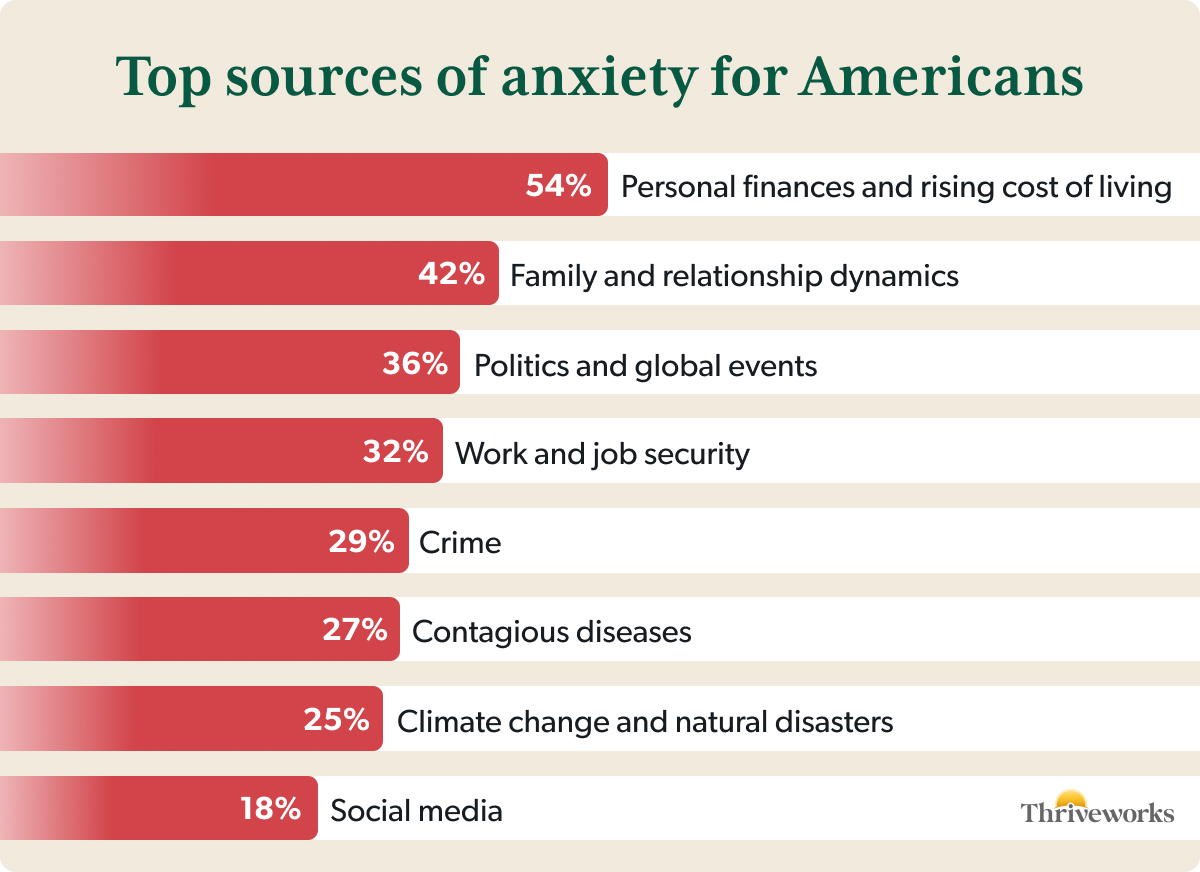
How People Work Therapy into Their Lives
Therapy is becoming an integral part of many Americans’ daily lives. Over one-third (36%) consider therapy an important component of their overall wellness routine, alongside healthy habits like regular exercise and balanced eating.
Life events and personal challenges often shape individuals’ decisions to seek therapy. More than half of respondents (52%) said they would consider attending therapy after experiencing a stressful or traumatic event. Similarly, 53% reported they would prioritize therapy during periods of feeling low or navigating difficult times.
What Benefits Do People Report Experiencing from Therapy?
For most Americans, therapy yields significant benefits. A large majority (87%) reported seeing meaningful improvements in their lives as a result of therapy. Key benefits highlighted by respondents include:
- Increased confidence in overcoming personal challenges (56%)
- Greater overall happiness (47%)
- Improved relationships with others (45%)
- Boosted self-esteem (45%)
- Better physical health (30%)
Only a small percentage (13%) stated they experienced little to no benefit from therapy, while 5% noted other positive outcomes not captured in this list.
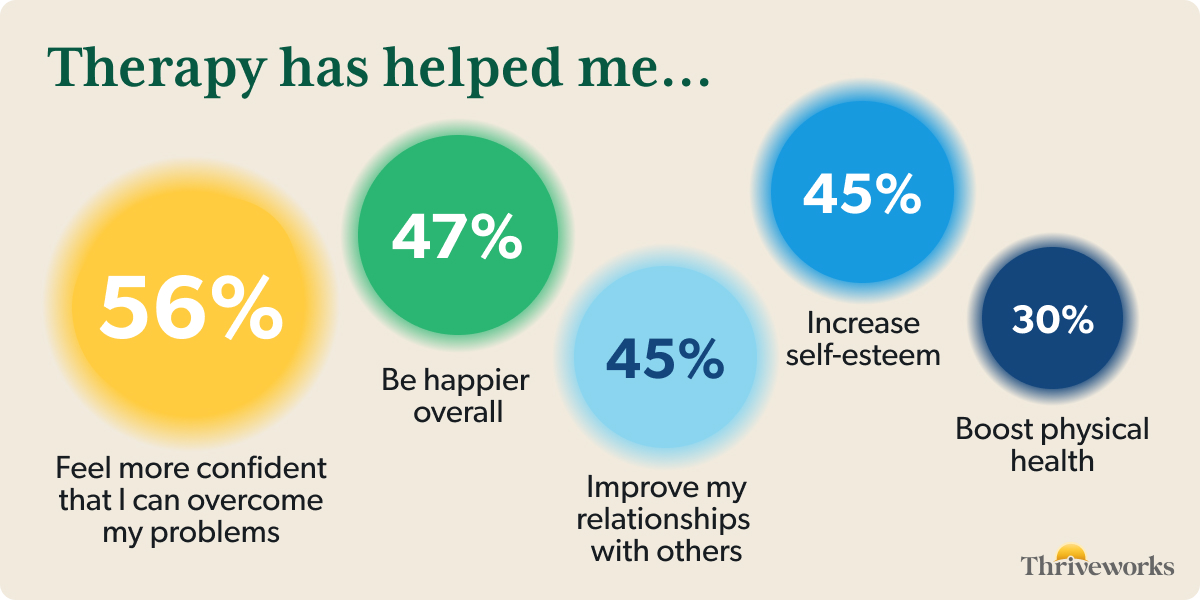
Perceived Relationship Between Physical and Mental Health
A growing body of research supports that physical and mental health are deeply interconnected. One recent study published in Nature Mental Health found that when organs like your heart, liver, or immune system aren’t doing well, it can actually change the structure of your brain, which can then lead to symptoms of depression and anxiety.
With this in mind, it’s not surprising that almost all respondents (93%) saw some link between mental health and physical health, with 44% saying they are completely intertwined and 49% saying they are sometimes connected.
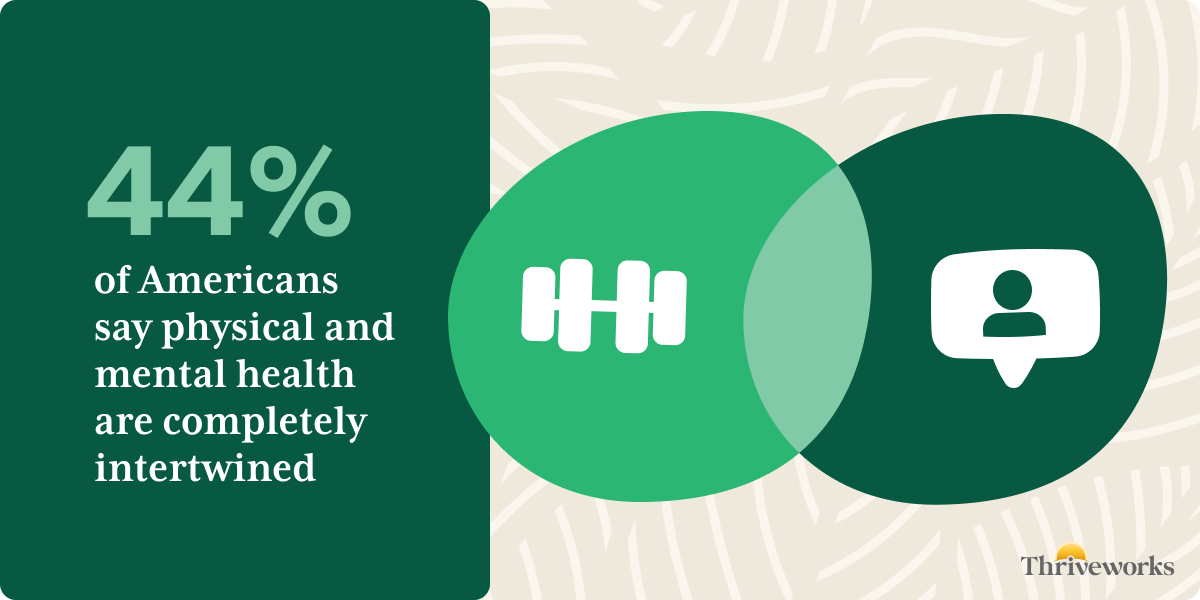
To see how this year’s results compare last year, check out the 2024 Pulse on Mental Health Report here.
*This study was conducted by Wakefield Research and commissioned by Thriveworks in February 2025 through an online survey of 2,000 US Adults.













